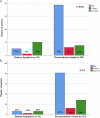Pitfalls of diagnosing pituitary hypoplasia in the patients with short stature
- PMID: 38969909
- PMCID: PMC11445333
- DOI: 10.1007/s12020-024-03951-9
Pitfalls of diagnosing pituitary hypoplasia in the patients with short stature
Abstract
Purpose: Height age (HA) and bone age (BA) delay is well known in the patients with short stature. Therefore assessing pituitary hypoplasia based on chronological age (CA) might cause overdiagnosis of pituitary hypoplasia. We aimed to investigate the diagnostic and prognostic value of the PH and PV based on CA, HA, or BA in the patients with GHD.
Methods: Fifty-seven patients with severe and 40 patients with partial GHD and 39 patients with ISS assigned to the study. For defining the most accurate diagnosis of pituitary hypoplasia, PH and PV were evaluated based on CA, BA and HA. The relationship of each method with clinical features was examined.
Results: The mean PV was significantly larger in patients with ISS compared to the GH-deficient patients. PV was more correlated with clinical features including height SDS, stimulated GH concentration, IGF-1 and IGFBP-3 SDS, height velocity before and after rGH therapy. We found BA-based PV could discriminate GHD from ISS (Sensitivity: 17%, specificity: 98%, positive predictive value: 94%, negative predictive value: 39%), compared to the other methods based on PH or PV respect to CA and HA. 3% of patients with ISS, 17% of patients with GHD had pituitary hypoplasia based on PV-BA.
Conclusion: PV based on BA, has the most accurate diagnostic value for defining pituitary hypoplasia. But it should be kept in mind that there might be still misdiagnosed patients by this method. PV is also a significant predictor for the rGH response.
Keywords: Bone age; Multiple pituitary hormone deficiency; Pituitary hypoplasia; Pituitary volume; Recombinant GH response; Short stature.
© 2024. The Author(s).
Conflict of interest statement
The authors declare no competing interests.
Figures
Similar articles
-
Growth response to growth hormone (GH) treatment in children with GH deficiency (GHD) and those with idiopathic short stature (ISS) based on their pretreatment insulin-like growth factor 1 (IGFI) levels and at diagnosis and IGFI increment on treatment.J Pediatr Endocrinol Metab. 2021 Jul 22;34(10):1263-1271. doi: 10.1515/jpem-2021-0389. Print 2021 Oct 26. J Pediatr Endocrinol Metab. 2021. PMID: 34291621 Clinical Trial.
-
Pituitary volume in children with growth hormone deficiency, idiopathic short stature and controls.J Pediatr Endocrinol Metab. 2016 Oct 1;29(10):1195-1200. doi: 10.1515/jpem-2015-0404. J Pediatr Endocrinol Metab. 2016. PMID: 27710916
-
Responses to growth hormone (GH) therapy in short children with normal GH secretion and no bone age delay: an analysis of potential factors affecting their response to rhGH therapy. A controlled study.Acta Biomed. 2019 Sep 23;90(8-S):43-51. doi: 10.23750/abm.v90i8-S.8506. Acta Biomed. 2019. PMID: 31544806 Free PMC article.
-
Magnetic resonance images of 91 children with different causes of short stature: pituitary size reflects growth hormone secretion.Eur J Pediatr. 1997 Oct;156(10):758-63. doi: 10.1007/s004310050707. Eur J Pediatr. 1997. PMID: 9365063 Review.
-
Controversies in the definition and treatment of idiopathic short stature (ISS).J Clin Res Pediatr Endocrinol. 2009;1(3):105-15. doi: 10.4008/jcrpe.v1i3.53. Epub 2009 Feb 1. J Clin Res Pediatr Endocrinol. 2009. PMID: 21274395 Free PMC article. Review.
References
-
- M. Maghnie, A. Lindberg, M. Koltowska-Häggström, M.B. Ranke, Magnetic resonance imaging of CNS in 15 043 children with GH deficiency in KIGS (Pfizer International Growth Database). Eur. J. Endocrinol. 168, 211–217 (2013). 10.1530/eje-12-0801 - PubMed
-
- M. Kessler, M. Tenner, M. Frey, R. Noto, Pituitary volume in children with growth hormone deficiency, idiopathic short stature and controls. J. Pediatr. Endocrinol. Metab. 29, 1195–1200 (2016). 10.1515/jpem-2015-0404 - PubMed
-
- A. Deeb, S. Attia, G. Elhag, A. El Fatih, J. Reddy, N. Nagelkerke, Pituitary gland size is a useful marker in diagnosing isolated growth hormone deficiency in short children. J. Pediatr. Endocrinol. Metab. 28, 981–984 (2015). 10.1515/jpem-2014-0209 - PubMed
-
- Sharma H., Purwar N., Kumar A., Sahlot R., Garg U., Sharma B., Mathur S.K. Pituitary hypoplasia is the best MRI predictor of the severity and type of growth hormone deficiency in children with congenital growth hormone deficiency. J Pediatr Endocrinol Metabol. 10.1515/jpem-2021-0049 (2021). - PubMed
-
- B.H. Nagel, M. Palmbach, D. Petersen, M.B. Ranke, Magnetic resonance images of 91 children with different causes of short stature: pituitary size reflects growth hormone secretion. Eur. J. Pediatr. 156, 758–763 (1997). 10.1007/s004310050707 - PubMed
MeSH terms
Substances
LinkOut - more resources
Full Text Sources
Miscellaneous


